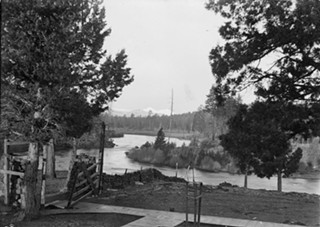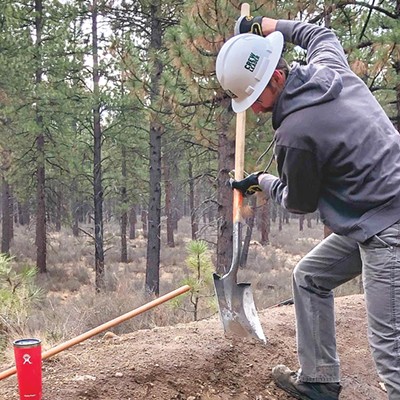The long wait is over.
Last week, the Mirror Pond Steering Committee rolled out seven potential solutions—much-anticipated visual representations of what could be done in regard to the silt-laden stretch of the Deschutes River as it runs past downtown Bend—and asked for public input. But don't break out the champagne just yet.
A recent meeting at City Hall for the River West Neighborhood Association, the first of five public information sessions hosted by Mirror Pond project manager Jim Figurski, revealed that the community divide regarding the river's future—and the proposed solutions—runs much deeper than Mirror Pond's shallow shoals.
What is inevitable is that the dam is going away, whether today or 10 years from now: Pacific Power representatives have already said Newport Avenue Dam "is a lot closer to the end of its usefulness" and called it "a small asset." Adding necessary alterations—like fish ladders—could extend the 100-year-old structure's life span, but those are extremely unlikely scenarios, as doing so would trigger action from the Federal Energy Regulatory Commission. And financing such FERC licensing would likely far exceed Pacific Power's current income from the hydroelectric facility, which powers less than 500 Bend homes.
But the timing of the dam's fate remains uncertain. The utility company has refused put a date on the dam's removal. Pacific Power's ambiguity leaves local officials, as represented by the Mirror Pond Steering Committee, with a complex set of options for managing Bend's central water feature—and needing to make that decision not knowing how much longer there will be a dam.
Within that context, though, here's how the proposed solutions, put forth by Mirror Pond Steering Committee and Management Board, break down:
A) do nothing;
B) dredge;
C) move and reuse existing sediment on site;
D) remove the dam and move the river's channel.
Each of the first three options (A-C) also comes with a twin proposal that allows for a no-dam scenario, if Pacific Power blows the dam sooner rather than later; thus there are seven options in total (the last option is built solely around a no-dam scenario; see sidebar).
The varying options drew strong reposes from the 50 or so River West neighbors who had gathered Monday night to listen to Figurski explain the nuances of each option.
"I'm sensing a strong bias against the dredging of the pond," said one balding neighbor, who clearly wanted to maintain the pond of his youth. "You can't conceive of the loss of support," he added, a weak threat aimed at The Bend Park & Recreation District should it, in conjunction with the city, decide to go against the man's wishes.
His bullheadedness turned off at least one of his fellow neighbors who walked out, grumbling and disappointed. "I'd like an intelligent debate," said the frustrated man when I caught up to him in the City Hall parking lot. "I'd like to see the river returned to its natural state."
Madeline Simmons, another River West neighbor, agreed. "I would be interested to see a decrease in the human impact," she said as she also left the meeting.
In addition to holding five public meetings, Figurski has created an online questionnaire to gauge community support for each of the seven options, as well as the dam's future. One of last questions asks: Would you like to see the dam removed? This survey is similar, but shorter, than the first survey released last winter. The cost of each plan, for both the river work and dam removal (if applicable), is included as well as a financial incentive for Pacific Power that numbers in the millions.
Figurski hopes that financial push is enough to encourage Pacific Power to make a call on the Newport Avenue dam removal. "It's cheaper as a joint venture, and more if they have to do it on their own," Figurski pointed out. "I'm hopeful and confident—maybe a mixture of both—that Pacific Power will step forward and make more of a definitive statement near the end of this process."
Removing the Newport dam on Pacific Power's own time, as described in the first option (A2, Do-Nothing with Dam Removal), would cost the utility company $10.9 million. However, working in conjunction with the community on the third option (C2, Move and Re-use Existing Sediment on Site) would only cost Pacific Power $5.3 million.
While neighbors and Bend stakeholders remain split—retain a pondlike feature or free the river—ecologists, fish biologists and river experts agree: A river without a dam allows for improved fish habitat and water quality.
Matt Shinderman, a member of the Mirror Pond Steering Committee and OSU-Cascades natural resources instructor, said he favors option C2 (on-site sediment reuse in a no-dam scenario). Ryan Houston, a Mirror Pond Management Board member and Upper Deschutes Watershed Council executive director, said he was inclined to agree and pointed to dredging-cycle options similar to the work done in 1984 (option B1) as shortsighted and foolhardy due to the maintenance required in another 20 to 30 years. Brett Hodgson, Oregon Department of Fish and Wildlife fish biologist, had a similar take.
"We're supportive of an option that would return the river to its free-flowing character," Hodgson said.
The next two public meetings are both from 5:30 pm to 7pm. They are set for Wednesday, June 19, and Tuesday, June 25, in the Bend Park & Recreation District Community Room, 799 SW Columbia St.
The Seven Options
(questionnaire, more information and graphics available at mirrorpondbend.com).
Note: All options save for D include scenarios with and without a dam. Dam removal is paid by its owner—currently Pacific Power.
A1-Do Nothing. Work: No work proposed for Mirror Pond. Cost: No up-front costs.
A2-Same, with Dam Removal. Work: Mitigate exposed soils. Cost: $10.9 million.
B1-Dredge. Work: remove 60,000 cubic yards of sediment, similar to 1984 dredging. Cost: $5.7 million.
B2-Same, with Dam Removal. Work: Similar to above, water drops to original channel. Cost: $5.3 million for dam removal, $11 million total.
C1-Move and Reuse Existing Sediment on Site. Work: Use sediment to create new public lands. Cost: $3.5 million.
C2-Same, with Dam Removal. Work: Similar to above, water drops to original channel. Cost: $5.3 million for dam removal, $8.8 million total.
D-Remove Dam and Modify River Channel. Work: Reduce wetlands adjacent to homes, create new public lands. Cost: $10.6 million total ($6.4 for sediment work, $4.2 for dam removal).
























